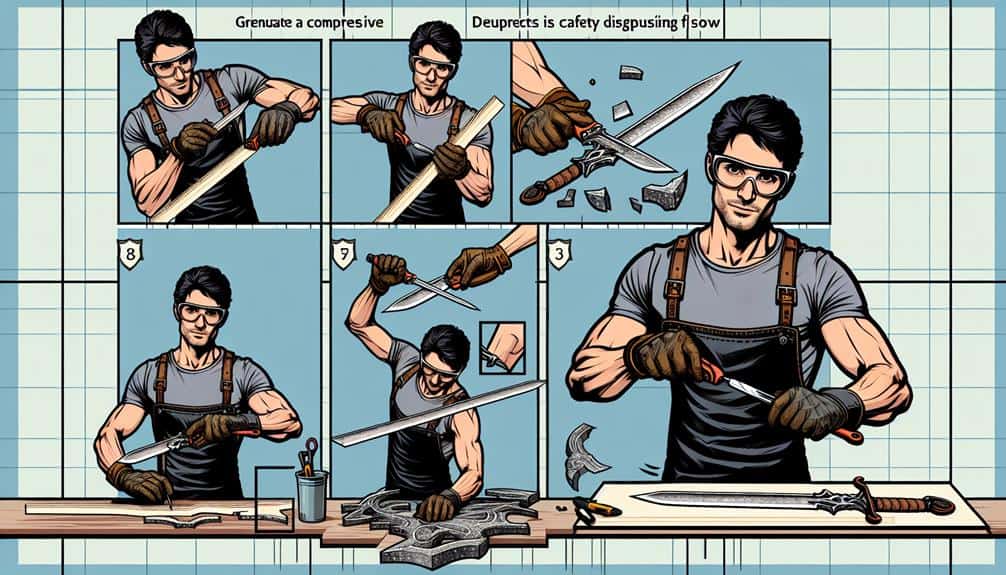If you're intrigued by the idea of crafting foam LARP weapons, you've come to the right place. Beginning your journey into the world of foam weaponry can be both rewarding and challenging. From selecting the right materials to mastering the art of creating sturdy yet safe weapons, each step is essential in honing your craft.
But before you plunge into the intricacies of foam shaping and painting, there's a vital foundation you must lay to safeguard your creations stand the test of battle. So, let's set off on this crafting adventure together, shall we?
Key Takeaways
- Choose closed-cell foams like EVA foam for durable and safe LARP weapons.
- Shape a sturdy core using PVC pipe or fiberglass rods for weapon stability.
- Layer foam evenly for protection, balance, and flexibility in your weapon.
- Craft a comfortable handle using materials like leather for control and grip in combat.
Materials Needed
To craft foam LARP weapons successfully, it's essential to gather the necessary materials before beginning the construction process. When selecting foam types for your LARP weapon, consider using closed-cell foams like EVA foam or camp pad foam for durability and safety. Closed-cell foams are vital as they absorb less water and are easier to clean. For cutting techniques, a sharp utility knife or foam cutter works best to guarantee clean and precise cuts. When cutting the foam, make sure to use a cutting mat to protect your work surface and to maintain the sharpness of your tools.
Foam types vary in density and flexibility, so choose according to the desired weight and feel of your weapon. EVA foam is commonly used for its balance between durability and flexibility. To achieve smooth edges, consider using a hot knife for cutting, as it seals the foam as it cuts, preventing fraying. Remember to always prioritize safety when cutting foam by wearing protective gloves and working in a well-ventilated area.
Building the Base Structure
Consider starting with a strong base for your foam LARP weapon by shaping a sturdy core using materials like PVC pipe or fiberglass rods. The base structure is important as it provides the foundation for your weapon's durability and performance. When selecting your core material, make it's lightweight yet sturdy enough to withstand combat. PVC pipe is commonly used for its affordability and ease of shaping, while fiberglass rods offer increased strength.
Foam thickness plays an important role in the safety and appearance of your LARP weapon. Thicker foam provides better cushioning and reduces the risk of injury during combat, but it may also affect the weapon's balance. Experiment with different foam thicknesses to find the right balance between safety and functionality for your weapon.
Shaping techniques are essential to create a realistic and effective weapon. Use tools like a utility knife, sandpaper, and heat gun to shape the foam to your desired form. Pay attention to detail, making smooth edges and a comfortable grip. Mastering these shaping techniques will elevate the quality of your foam LARP weapon.
Adding Foam Layers
When adding foam layers to your foam LARP weapon, make sure a smooth and even application for best cushioning and protection during combat. To achieve ideal results, consider the following:
- Foam Thickness: Selecting the right foam thickness is pivotal. Thicker foam provides more cushioning but may make the weapon heavier and less flexible. Thinner foam offers more flexibility but mightn't absorb impacts as effectively. Find the balance that suits your combat style.
- Layering Technique: Apply foam layers evenly to guarantee consistent protection. Start by wrapping the foam tightly around the core, securing it with duct tape. Then add successive layers, slightly overlapping each other to prevent weak spots. This method enhances durability and impact absorption.
- Smooth Transition: Blend each layer smoothly to avoid creating hard edges that could cause discomfort or injury during combat. Use a sharp blade to trim excess foam and shape the layers seamlessly for a professional finish.
- Test and Adjust: After adding each layer, test the weapon's flexibility and cushioning. Make adjustments as needed to achieve the ideal balance of protection and usability.
Crafting the Handle
Craft your LARP weapon handle with precision, ensuring a comfortable grip and supreme control during intense combat scenarios. When crafting the handle, consider the handle wrapping and grip design carefully. The handle wrapping not only provides a secure grip but also adds to the aesthetic appeal of your weapon. Choose materials that are vital and offer a good grip, such as leather or suede. Experiment with different wrapping techniques to find what suits your weapon best.
Weight distribution and balance tuning are vital aspects of crafting the handle. A well-balanced weapon ensures that you can wield it effectively without straining your arm. Play around with the placement of weights within the handle to achieve the desired balance. Remember that the handle should feel comfortable in your hand and allow for swift movements during combat. Once you have achieved the perfect balance, your weapon will feel like a natural extension of your arm, ready to face any challenge on the battlefield.
Painting and Finishing Touches
Enhance the visual appeal and durability of your LARP weapon by carefully selecting paint colors and applying protective finishes to give it a professional look and long-lasting quality.
To achieve a truly impressive finish, consider the following steps:
- Express Your Creativity: Express your creativity by painting unique symbols, patterns, or even emblems onto your weapon. This personal touch can make your LARP weapon stand out on the battlefield.
- Weathering Techniques: Use dry brushing or sponge painting to add a weathered effect to your weapon, giving it a battle-worn appearance that adds depth and character.
- Shiny Finishes: For a polished look, consider adding a glossy finish to your weapon. This won't only make the colors pop but also provide an extra layer of protection.
- Textured Details: Incorporate textured finishes like stone, wood grain, or metal effects to elevate the realism of your weapon. These details can make your foam weapon look like authentic medieval gear.
Frequently Asked Questions
Are There Any Safety Precautions I Should Take When Using Foam Weapons in LARP Combat?
When wielding foam weapons in LARP combat, prioritize safety. Proper foam weapon care guarantees durability and safety. Combat safety is essential; always wear appropriate protective gear and follow event rules. Stay sharp, stay safe!
How Long Can I Expect a Foam Weapon to Last Before Needing Repairs or Replacement?
Foam weapon durability depends on maintenance and use. With proper care, weapons can last for many battles before needing repairs. Regular inspections, avoiding excessive force, and proper storage can extend their longevity.
Are There Any Specific Techniques for Maintaining and Cleaning Foam Weapons?
For cleaning tips, maintenance techniques, storage advice, and repair methods for foam weapons, never underestimate the power of a good scrub! Remember, regular care guarantees longevity. Treat your weapon with care, and it'll serve you well.
Can Foam Weapons Be Customized or Modified After They Have Been Completed?
You can personalize foam weapons by painting intricate designs. Repairing damage is easy with simple fixes like re-taping or gluing. Upgrading is possible by adding layers or changing the weapon's structure for enhanced performance in LARP battles.
Are There Any Rules or Guidelines Regarding the Use of Foam Weapons in LARP Events or Organizations?
When using foam weapons in LARP events or organizations, remember to adhere to foam weapon regulations and safety measures. These guidelines guarantee a fun and safe experience for all participants, promoting an environment of creativity and fair play.



